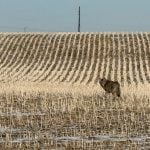New strides in agricultural innovation were the featured topic at the University of Guelph Feeding The Future discussion at Canada’s Outdoor Farm Show 2025.
The event brought together growers, livestock producers, researchers, policymakers, and industry partners in celebration of Ontario’s agri-food sector.
Jocelyn Smith, an assistant professor of field crop entomology at Guelph, shared ongoing challenges facing farmers as pest-resistant crops continue to emerge in Ontario.
Read Also

Women who fed a nation
More than 40,000 young women supported the war effort between the 1940s and early 1950s, helping grow and harvest crops amid labour shortages. They were called Farmerettes.
“Pests keep changing, and new pests come into Ontario. We need to learn about them,” she said, adding that her department continues to develop monitoring programs to test and evaluate new pest control products.
She noted that there is also ongoing evaluation of old economic thresholds in an effort to develop more cost-effective treatment options.
As of 2006, she said that there has been an increase of insecticide-resistant corn, with the most common pest threat being the European corn borer.
She said that 85 per cent of corn grown in Ontario is genetically modified. As of 2018, she noted that there has been resistance discovered in Nova Scotia.
To help slow the spread of resistance, she added that her team is partnering with organizations across Canada and the United States to develop further prevention programs.
Maximizing Calf Health
Michael Steele, a professor with the department of animal biosciences, continued the discussion, sharing updates on his team’s research to enhance the quality of breeding calves in Ontario.
He noted that 40 per cent of calves in Ontario are crossbred beef animals, as producers are breeding more of their lower end dairy cows to beef cows.
He added that research is also being done to reduce the level of microbial use during the early stages of calving. Genetic markers are also being traced among bulls to select the best breeding options.
The next stage of research, he added, is post-weaning nutrition. He said many calves are given a high-starch diet and that new research will explore if this is an environmentally friendly and healthy option, versus other diet alternatives.
The overall objective is to develop a better understanding of how pre-weaning nutritional and management factors can impact gastrointestinal development and metabolism during the pre-weaning phase and later in life.
For more coverage of Canada’s Outdoor Farm Show 2025, see our landing page.















